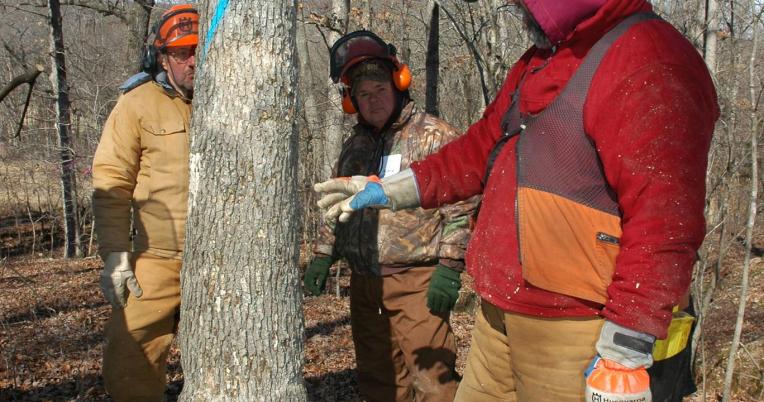Charged with managing Missouri’s forest resource, MDC is sometimes called upon to provide information and justification of management activities on more than just biological grounds. What is the economic impact of Missouri’s forest products? To answer this, MDC undertakes periodic assessments of the economic impact of the forest products industry on the state as a whole by working with data collected by the Federal government
Missouri Shortleaf Pine Utilization Summary (PDF, 638 KB)
The Missouri Shortleaf Pine Utilization Assessment serves as a comprehensive and strategic resource for the Forest and Woodland Association of Missouri (FWAM), federal and state agencies, loggers, sawmills, and secondary wood product manufacturers by identifying key opportunities to expand markets for Missouri-grown shortleaf pine. This report provides data-driven insights to drive targeted growth in shortleaf pine manufacturing, empowering stakeholders to enhance economic viability, strengthen forest management, and improve industry competitiveness while supporting multi-tiered landscape restoration and ecological objectives.
Published on Jun 30, 2025 -MO SLP Utilization Assessment (PDF, 16 MB)
Shortleaf pine (Pinus echinata) has the broadest geographic range of any southern pine species, spanning 22 states from southeastern New York to eastern Texas. Historically, Missouri’s forests were dominated by this resilient species, covering an estimated 6.6 million acres prior to European settlement. Today, only a small portion of shortleaf pine remains, primarily within the southern portion of the state.
In today’s markets, shortleaf pine is often viewed as a financial burden rather than an asset. Inconsistent pricing, weak demand, and limited processing infrastructure have made harvesting shortleaf economically unviable for many timber harvesters, who often face harvesting costs that exceed potential sale prices. As a result, forest managers report few bids on timber sales with a significant pine component, leading to scenarios where shortleaf pine is either left standing or felled to meet silvicultural objectives, but then left to lay on the harvest site. Without expanded markets, this valuable resource remains underutilized, hindering both forest health and economic opportunities.
Published on Jun 25, 2025 -THE BENEFITS OF SLOW-GROWTH SHORTLEAF PINE LUMBER IN MISSOURI (PDF, 2 MB)
Missouri's forests are home to a variety of valuable tree species, including Shortleaf Pine (Pinus echinata). Natural regeneration Shortleaf Pine found in Missouri’s forests is characterized by slow tree growth and tight
growth rings, provide a source of high-quality lumber prized for its strength and stability. In contrast, fast-growing plantation Shortleaf Pine has become increasingly common. This shift raises concerns about potential
differences in lumber quality, particularly when compared to the desirable characteristics of lumber from slow-growth, natural forests. This paper will discuss the benefits of lumber sawn from natural forest slow-growth
Shortleaf Pine in Missouri, with a focus on its superior dimensional stability and mechanical properties - attributes that make it comparable to the old-growth timber of previous generations. This report is a
component of the “Missouri Shortleaf Pine Utilization Assessment”.
2022 MDC Timber Product Output Report (PDF, 819 KB)
In the spring and early summer of 2023, the Missouri Department of Conservation interviewed mill owner/operators from a random-sample of primary wood processors throughout the state, asking for information on their firms from 2022. In this report we present forest industry trends, harvest levels and other details. Such detailed information is necessary for intelligent planning and decision making in wood procurement, forest resources management, and forest industry development. Likewise, researchers need current forest industry and industrial roundwood information for planning projects.
Published on Sep 14, 2023 -Science Note - Forestry Economic Impact - up to 2023 data.pdf (PDF, 247 KB)
What would life be like if Missouri had no forests? Besides being a lot less pleasant, scenic and enjoyable for us and the plants and animals that rely on Missouri’s forests, Missouri’s wallets would take a big hit! Working with data collected by the Federal government, other branches of state government and the Missouri Department of Conservation’s (MDC) own foresters, MDC undertakes periodic assessments of the economic impact of the forest products industry on the state as a whole.
Economic impact analysis (EIA) examines the effect of a policy, program, project, activity or event on the economy of a given area. The area can range from a neighborhood to the entire globe. Economic impact is usually measured in terms of changes in economic growth (output or value added) and associated changes in jobs (employment) and income (wages). The analysis typically measures or estimates the level of economic activity occurring at a given time with the activity occurring, and calculating the difference from what would otherwise be expected if the activity did not occur (which is referred to as the counterfactual case). This analysis can be done either before or after the fact (ex ante or ex post). The term economic impact can be applied to analysis of the economic contribution of a given activity or industry to the existing local economy.
Published on Sep 30, 2024 -

